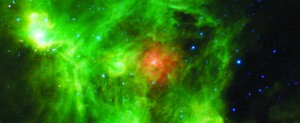During the fall semester, sc ience teacher Darian Cork showed his Earth Science students a way for them to photograph various stars, nebulas and planets, all from the comfort of their own desks.
ience teacher Darian Cork showed his Earth Science students a way for them to photograph various stars, nebulas and planets, all from the comfort of their own desks.
In order to do this, Cork had to complete a program known as PROMPT telescopes. For this program, UNC-Chapel Hill invites interested teachers to learn how to use Skynet, a computer program used to manipulate telescopes located at the Cerro Tololo Inter-American Observatory in the Chilean Andes.
When the programs were made available to Cork’s classroom, students were able to use their knowledge of astronomy from class to locate different planets and nebulas, which are clouds of gas and dust in outer space.
“The students log on during the day and they plug in observations of different nebulas and different stars or planets that they wish to take a look at. Then they receive photographic images of one portion of the spectrum the next day,” said Cork.
Freshman Elizabeth Hart enjoyed getting to use the telescopes provided by UNC for a few days.
“It was interesting to see what pictures you could take; some were really cool,” said Hart.
These techniques are the same that the students at UNC-Chapel Hill are using in their astronomy classes.
“They tell the computer to take these pictures using these same telescopes,” said Cork.
Cork enjoys teaching his students how to use this new technology to learn about the universe because it allows them to be more hands-on during the astronomy unit of his class.
“They understand concepts that are just remote, inaccessible, abstract ideas and this program presents it to them in a way that they can manipulate and see their results and actually understand [them],” said Cork.
Cork feels there is a need to bring back Northwood’s astronomy class due to a rise in student interest. The class was taught by Cork in 2006, but when there weren’t enough teachers to equal the amount of electives being offered, the class was dropped.
Since these telescopes have been built, researchers do not have to go out in the field to do their observations and can instead rely on the telescopes to give them the photographs they need.
“The reality is that these telescopes are so advanced now that you can set your apertures on your observations…it takes less than 10 seconds for these images to be taken,” said Cork.
Senior Becky Jurius appreciated the hands-on experience she got when she was in Cork’s Earth Science class as a freshman.
“This program gives kids the opportunity to see what they have never seen before. Being able to look at the stars that are so far away was the most interesting part of the whole experience,” said Jurius.
Cork would like to see the school with more up-to-date equipment that will be able to handle larger amounts of information. He plans on showing this program to the Science Club this spring.
“This program can provide another meaningful resource for the students…it gives them the opportunity to use equipment other than the lab equipment here to expand on their knowledge of science,” said Cork.
— By Kristen Hutchinson
